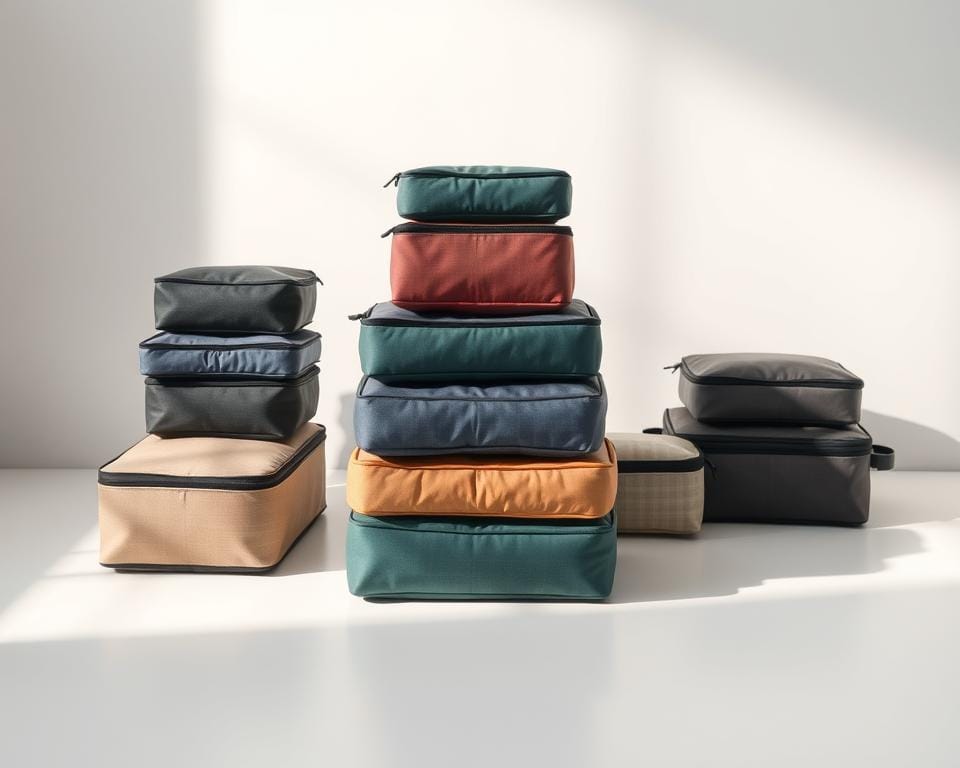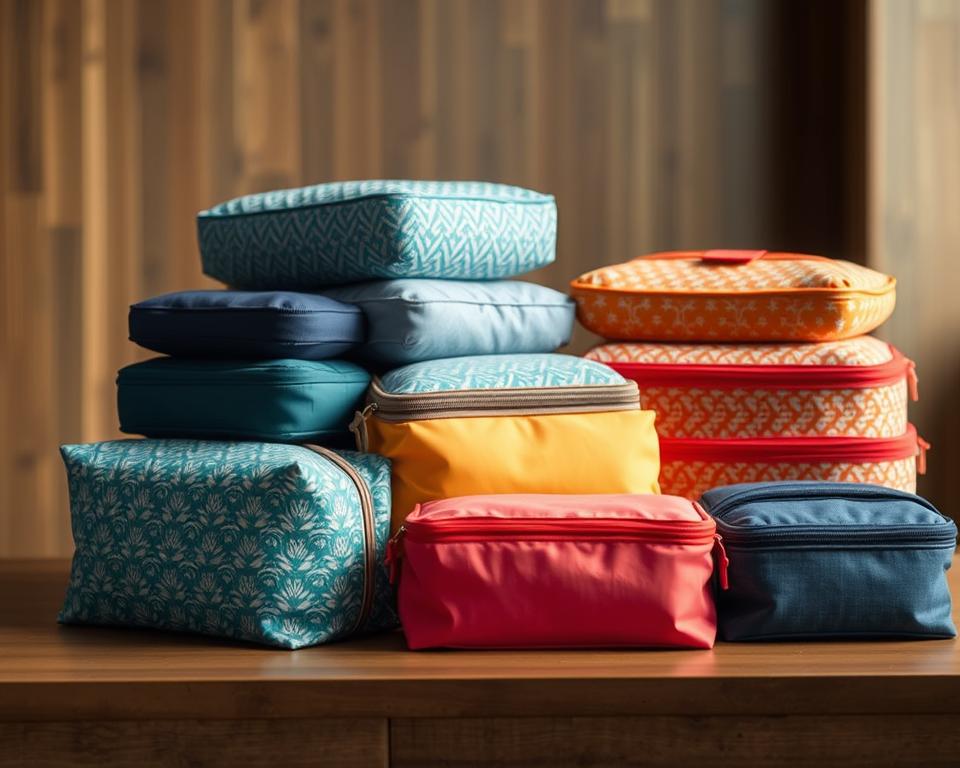Ever wondered why some travellers glide through airports while others wrestle with bursting suitcases? The secret might just lie in those clever fabric compartments quietly revolutionising travel organisation.
I used to dread packing. My suitcase resembled a jumble sale – wrinkled shirts, tangled cables, and that one missing sock haunting every trip. Then I discovered these organisational marvels. Suddenly, my clothes stayed sorted, my toiletries stopped leaking onto everything, and closing my luggage became a satisfying click rather than a battle.
Travel experts agree these tools help maintain order throughout your journey. They’re not just for folding – they create systems. Separate clean outfits from worn clothes. Compress bulkier items. Even locate your passport quickly during rushed security checks. Forgot the pre-flight scramble where you sit on your case to zip it? That vanishes too.
Key Takeaways
- Transforms chaotic luggage into compartmentalised systems
- Keeps clean and worn items separated throughout trips
- Reduces wrinkles and prevents last-minute packing panic
- Works equally well for business trips and family holidays
- Establishes foundational habits for efficient travel routines
Whether you’re jetting off for work or a fortnight in Spain, mastering these space-saving heroes changes how you approach travel. Let’s explore how to maximise their potential – your future self will thank you at baggage reclaim.
Understanding Packing Cubes
Staying organised while travelling can feel like a constant battle against chaos. That’s where these fabric organisers step in – they’re like personal assistants for your suitcase. I’ve found they transform messy luggage into a grid of tidy compartments, making everything from socks to sunglasses instantly findable.
What Are Packing Cubes?
Think of them as zippered rectangles that slot into your luggage like puzzle pieces. Most are made from lightweight nylon or eco-friendly materials, with mesh panels showing what’s inside. My favourites have compression zippers – squeeze them shut and watch bulky jumpers become flat parcels.
Benefits for a Neater Travel Experience
These organisers help keep clothes crisp by separating folded shirts from shoes. No more digging through piles to find your toothbrush! They also:
- Maximise every inch of space (goodbye, half-empty suitcases)
- Prevent wrinkles by keeping items snugly in place
- Let you unpack in seconds by moving cubes straight to hotel drawers
I’ve noticed something unexpected too – using them reduces that “Did I forget something?” anxiety. When everything has its place, you travel lighter mentally as well as physically.
How to Use Packing Cubes
Ever opened your suitcase to find yesterday’s socks cuddling your toothbrush? That chaos ends today. Let’s create a luggage system that survives airport turbulence and hotel hopping.

Matching Compartments to Your Needs
Size matters more than you’d think. My small cubes handle pants and vests – they’re perfect for keeping delicates separate. Medium ones swallow shirts without wrinkling collars. Save the largest for jumpers or shoes.
Category Is King
Marie Kondo’s “joy check” works wonders here. Lay out everything first, then group by:
- Essentials (undergarments, sleepwear)
- Outer layers (jumpers, jackets)
- Activity-specific gear (gym kit, swimwear)
I dedicate one cube to work attire and another to casual outfits. For weekend trips? A single cube per day keeps things simple.
Lessons From My Travel Blunders
Through trial and error, I’ve learned to:
- Leave 25% space in each cube for souvenirs
- Use compression zippers only on bulky items
- Store jewellery in mesh pockets to prevent tangles
Stick to 3-5 cubes max – any more and you’ll waste time rummaging. My game-changer? Assigning coloured cubes to family members during group trips.
Organising Your Suitcase for Stress-Free Travel
We’ve all experienced that sinking feeling when opening our luggage to find clothes avalanching towards us. Strategic cube placement solves this beautifully – it’s like building a wardrobe that travels. Here’s what works for me after years of trial and error.
The Art of Spatial Tetris
Start by placing your largest cube opposite your suitcase’s strap side – this creates counterbalance when carrying. From there, fit smaller compartments like puzzle pieces. I often stand slim cubes vertically beside shoes, creating natural dividers. Rolled jumpers? Slot them horizontally across the top.
Three game-changing rules I live by:
- Zippers always face upwards – no flipping cubes during hotel unpacking
- Heaviest items sit wheel-side to prevent suitcase toppling
- Leave 2cm gaps between cubes to absorb movement during transit
During my last city break, this system kept everything intact despite three train changes. The secret? Cubes act as shock absorbers when snugly fitted. I even slide a flat one between my laptop and clothes for extra protection.
For quick access, designate a top-layer cube with essentials like chargers and passports. Mine has a bright orange pull tab – impossible to miss during security checks. Remember, good organisation isn’t restrictive. It’s what lets you spontaneously grab that extra souvenir without chaos.
Efficient Packing Techniques
Nothing kills holiday vibes faster than rummaging through hotel drawers for a specific top. Through years of trial, I’ve honed methods that keep garments organised from departure to homecoming. Let’s explore what actually works when space and sanity matter.
Folding vs Rolling: My Personal Experience
Denim taught me rolling’s limits. While perfect for cotton tees, my best jeans developed stubborn creases when coiled. Now I file-fold thicker fabrics vertically like books on a shelf – instant visibility without wrinkles. For silk blouses? Rolling from hem to collar prevents slippage in transit.
Marie Kondo’s technique transformed my medium cubes. Standing folded shirts upright creates 20% more space than traditional stacking. Pro tip: match garment widths to your cube’s interior. My go-to combo:
- Vertical folds for trousers and structured clothing
- Tight rolls for gym wear and swimsuits
- Layering delicates flat in mesh-top cubes
Labelling and Categorising for Quick Access
Colour-coded ribbons solved my 6am outfit scrambles. I stitch different hues to cube zippers – crimson for work attire, teal for leisurewear. For shared luggage, washi tape labels on mesh panels display contents at a glance.
My foolproof system uses three visual cues:
- Patterned cubes for seasonal clothing
- Safety-pinned tags with day numbers
- Transparent pouches inside for toiletries
After seven countries and countless laundry days, this approach keeps everything shipshape. The real win? Unpacking takes 90 seconds flat – more time for exploring.
Packing Cubes for Various Travel Scenarios
Different journeys demand different strategies – what works for a solo business trip might fail spectacularly on a family holiday. Through trial and error, I’ve developed tailored systems that adapt to any adventure’s unique rhythm.
Colour-Coding Chaos Control
Family holidays require military precision. Assign each member a specific cube colour – my daughter’s pink cubes contain pre-rolled outfits, while my partner’s navy ones hold walking gear. This approach:
- Prevents “Whose socks are these?” meltdowns
- Lets kids pack their own cubes (stickers help younger ones)
- Creates visual cues for quick morning routines
For babies, I dedicate two cubes per day – one for clean essentials, another for soiled items. Mesh panels let you spot nappies or muslins instantly without unpacking.
Business Savvy Meets Practicality
Work trips need wrinkle-free efficiency. I pack suits in slim compression cubes – the tight fit keeps creases at bay. A separate organiser houses chargers and adapters, while toiletries live in leak-proof side pockets.
Long-term travellers should try the “flip and rotate” method. Use two identical cubes – when one’s empty, it becomes the dirty laundry holder. Compression models work wonders for squeezing in souvenirs without buying extra bags.
Maximising Luggage Space and Reducing Wrinkles
The true magic happens when your suitcase zips shut effortlessly, leaving room for that extra souvenir. Mastering compression techniques transformed my approach to packing – gone are the days of sitting on my case like a panicked penguin guarding its egg.

Compression Packing Tips
That second zipper isn’t just for show. Start by folding bulkier items flat, then use the first zip to seal your cube. Engage the compression zipper gradually, working from both ends to distribute pressure evenly. Through trial and error, I’ve learned:
- Jumpers and jeans compress beautifully – down jackets become pancake-thin
- Delicate blouses wrinkle horribly – keep them in standard cubes
- Overfilled cubes create stubborn creases – leave 3cm expansion space
Space-Saving Strategies in Your Suitcase
Layer compressed cubes wheel-side down – their flat profiles create stable foundations. Fill awkward gaps with rolled belts or socks. My go-to system:
- Base layer: Two compressed cubes with heavy knits
- Middle zone: Regular cubes for structured clothing
- Top section: Half-empty cube for souvenirs
Bonus trick? Slide thin items like scarves between cube handles and suitcase walls. This exploits every millimetre without crushing your carefully folded pieces. Just remember – saved space shouldn’t mean overpacking. Use that new room for lightweight treasures, not extra shoes.
Conclusion
Transform your travels from frantic searches to smooth sailing with one simple shift. These organisational heroes turn chaotic luggage into sorted systems – I’ve gone from last-minute panics to breezy airport dashes thanks to their magic.
Your new travel rhythm awaits: sorted outfits that stay crisp, quick-access essentials, and designated spaces for laundry. Remember to match cube sizes to your trip length and use compression zips wisely. Colour-coding works wonders for family trips, while slim organisers keep business attire sharp.
Struggled before? So did I. Now I toss cubes straight into hotel drawers – unpacking sorted in seconds. Adapt these tricks for any destination: roll beachwear for tropical escapes, fold layers for city breaks. The real win? More mental space to enjoy adventures instead of rummaging through bags.
Start small. Try categorising tops in one cube and shoes in another next trip. Refine your system as you go – what works for weekend escapes might evolve for month-long journeys. Your next adventure awaits – neatly packed and ready for discovery.

